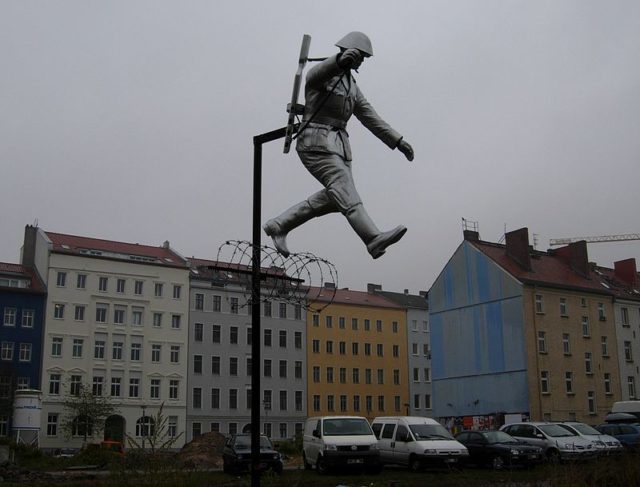Many of you have probably heard the name Conrad Schumann. He was an East German soldier who became famous for defecting to West Germany as the Berlin Wall was being constructed in 1961.
On 15 August 1961, Schumann, who was 19-years-old at the time, was sent to the intersection of Bernauer Street and Ruppiner Street to guard the Berlin Wall on the third day of assembly. At that time, the wall was only a single coil of razor wire.

From the other side of the wire, West Germans were shouting to him, Komm’ rüber! – “Come over.” A West German police car pulled up and sat there waiting for him. Schumann dropped his submachine gun, leaped over the barbed wire, quickly jumped into the police car, and was driven away from the area by the West Berlin police.
On the spot, West German photographer Peter Leibing photographed the whole escape scene. A picture of the breakout has since become an iconic image of the Cold War era and is featured at the beginning of the Disney film Night Crossing which came out in 1982.
Later, Schumann came to the realization that he was somewhat free when he was later permitted to travel from West Berlin to any part of the territory of West Germany. He finally settled in Bavaria, and he met his wife Kunigunde in the town of Günzburg.

After the collapse of the Berlin Wall Schumann once said, “Only since November 9, 1989 – the date of the fall of the Berlin Wall – have I felt truly free.” Even so, he began feeling more at home in Bavaria than he ever did in his birthplace – mentioning old hostilities with his former East German soldiers and being tentative about visiting his parents and siblings in the state of Saxony in the former East Germany.
On 20 June 1998, he committed suicide. He hanged himself in his orchard near the town of Kipfenberg in Upper Bavaria. At the time he was suffering from depression.

In May 2011, the UNESCO Memory of the World inducted the photograph of Schumann’s “leap to freedom” into their program as part of a collection of images and documents concerning the collapse of the Berlin Wall.
Florian and Michael Brauer and Edward Anders’ sculpture, called Mauerspringer (Wall jumper) could once be seen close to the site of Schumann’s defection but has since been moved to the side of a building on Brunnen Street, several meters south of Bernauer Street.
